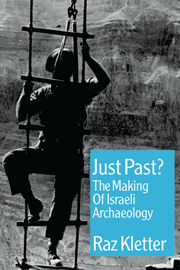Book contents
- Frontmatter
- Dedication
- Contents
- List of illustrations
- Introduction
- Acknowledgements
- Abbreviations
- 1 Archaeology and the 1948 War
- 2 Abandoned places, new places
- 3 Foreign aid
- 4 Frozen funds
- 5 A battalion of guards
- 6 Relief work
- 7 Man robs his land: “agreement” with General Dayan
- 8 “Gold of Ophir for Beth-Horon”: 3,000 shekels
- 9 The building beyond the border: the PAM, 1948–67
- 10 A building of dreams: a home for the IDAM and the origins of the Israel Museum, Jerusalem
- 11 A dead man on the council: the story of the supreme archaeological body in Israel
- 12 “But trust comes from the heart”: travels with the Government Tourist Corporation
- 13 “Whether in a courtyard of a synagogue, in a courtyard adjacent to a synagogue, or under a synagogue”: the Safad affair
- 14 The policy of salvage and early Israeli excavations
- 15 Myths and conclusions
- Appendix: other documents from the IDAM files
- Bibliography
- Author index
- Index
13 - “Whether in a courtyard of a synagogue, in a courtyard adjacent to a synagogue, or under a synagogue”: the Safad affair
- Frontmatter
- Dedication
- Contents
- List of illustrations
- Introduction
- Acknowledgements
- Abbreviations
- 1 Archaeology and the 1948 War
- 2 Abandoned places, new places
- 3 Foreign aid
- 4 Frozen funds
- 5 A battalion of guards
- 6 Relief work
- 7 Man robs his land: “agreement” with General Dayan
- 8 “Gold of Ophir for Beth-Horon”: 3,000 shekels
- 9 The building beyond the border: the PAM, 1948–67
- 10 A building of dreams: a home for the IDAM and the origins of the Israel Museum, Jerusalem
- 11 A dead man on the council: the story of the supreme archaeological body in Israel
- 12 “But trust comes from the heart”: travels with the Government Tourist Corporation
- 13 “Whether in a courtyard of a synagogue, in a courtyard adjacent to a synagogue, or under a synagogue”: the Safad affair
- 14 The policy of salvage and early Israeli excavations
- 15 Myths and conclusions
- Appendix: other documents from the IDAM files
- Bibliography
- Author index
- Index
Summary
Everything discovered so far is but the mere beginning from the hidden [genuzim] treasures, in which the scroll of lineage and sovereignty of Israel over its land is folded.
Aranne (1957: 100)There is evidence, however, that at that time the question whether the presence of such an animal might be tolerated in the house of God was investigated from the point of view of the Law and the Commandments.
Kafka (1935: 57)A series of letters reveals an affair that was never published. It concerns a plan by Dr John Bowman of the Department of Semitic Languages and Literature at the University of Leeds, together with a converted Jew from Edinburgh, the Reverend Nahum Levison, to excavate “genizot” of Synagogues in Safad and near the famous tomb of Shimeon Bar Yochai at Mount Meiron. The Hebrew word genizah is roughly equivalent to the Latin favissa: an underground or closed treasury of religious objects, such as Torah scrolls that were damaged or worn and could no longer be used. The plan involved not only Yeivin, but also the second President of Israel, Itzhak Ben-Zvi.
The correspondence mainly consists of letters by Bowman and Yeivin, kept in GL44881/13, with some additions in GL44880/13. The University of Leeds was one of the first foreign institutions to excavate in Israel (in Jaffa in 1952; Bowman & Isserlin 1955).
- Type
- Chapter
- Information
- Just Past?The Making of Israeli Archaeology, pp. 284 - 294Publisher: Acumen PublishingPrint publication year: 2006



